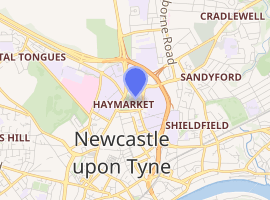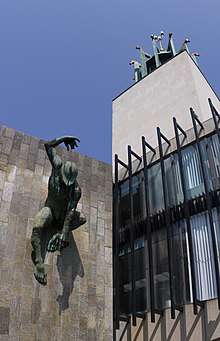Newcastle Civic Centre
Newcastle Civic Centre is a local government building located in the Haymarket area of Newcastle upon Tyne, England. It is the main administrative and ceremonial centre for Newcastle City Council.[1] Designed by the city architect, George Kenyon,[2] the building was completed in 1967 and was formally opened by HM King Olav V of Norway on 14 November 1968.[3] It is a Grade II* listed building.[4] The Newcastle Civic Centre is the joint eighth tallest building in the city, and stands a total of 200 feet (61 m) tall.[5]
| Newcastle Civic Centre | |
|---|---|
Newcastle Civic Centre | |

| |
| General information | |
| Location | Newcastle upon Tyne |
| Address | Barras Bridge, Newcastle upon Tyne NE1 |
| Coordinates | 54.9790°N 1.6109°W |
| Completed | 1967 |
| Inaugurated | 14 November 1968 |
| Owner | Newcastle City Council |
| Height | 200 ft (61 m) |
| Design and construction | |
| Architect | George Kenyon |
| Designations | |
Listed Building – Grade II* | |
| Official name | Civic Centre |
| Designated | 16 November 1995 |
| Reference no. | 1242692 |
History
Plans to build a new city hall[6] on the site at Barras Bridge had been proposed prior to the outbreak of the Second World War, to the point of holding an architectural competition, although these were halted by the war;[7] and due to post-war restrictions on capital expenditure, it was not until August 1956 that authorisation to begin construction was granted. During the interim period, the demolition of houses and a former Eye Hospital on the intended site was implemented.[3] The building was designed by the city architect, George Kenyon.[2]
The construction work, which was undertaken by Sir Robert McAlpine,[8] commenced on the building in May 1960, and the foundation stone was laid by the Lord Mayor, Alderman Mrs Gladys Robson, on 30 November 1960. The building was completed in 1967 and was formally opened by HM King Olav V of Norway on 14 November 1968. The total construction cost was £4,855,000.[3] Newcastle's Victorian Town Hall which stood in St Nicholas Square (between the Bigg Market and the Cloth Market) was demolished in 1973.[9] On 6 May 1977, the Civic Centre was visited by the 39th President of the United States, Jimmy Carter, who delivered a speech famously containing the Geordie phrase "Howay the lads!"[10] A stone commemorating the event was placed in the Centre grounds.[11]
The council leader's office was used as a filming location by a Japanese production team in 2014 for a drama set in 1960s Tokyo.[12]
Sculpture and art works

The Civic Centre is also notable for its modern sculptures, in particular the "River God Tyne" and "Swans in Flight", both by David Wynne and the seahorses on the top of the tower by John Robert Murray McCheyne.[13] The cashiers reception of the former rates hall, now the Customer Service Centre, has two abstract murals by Victor Pasmore.[14]
References
- Official website, URL accessed 12 March 2007.
- Northumbria.info, URL accessed April 22, 2007
- Official website, URL accessed 12 March 2007.
- Historic England. "Details from listed building database (1242692)". National Heritage List for England. Retrieved 12 June 2011.
- "Newcastle Civic Centre". Emporis. Retrieved 8 August 2020.
- Not to be confused with Newcastle City Hall, a concert hall
- Keiran Southern (2015-07-15). "Newcastle Civic Centre: A history of one of the city's most recognised buildings". Chronicle Live. Retrieved 2017-10-30.
- "Civic Centre Barras Bridge Newcastle upon Tyne Unknown c.1960". Newcastle Libraries. Retrieved 24 April 2016.
- David Morton (22 May 2014). "Remember When: Newcastle's Bigg Market - then and now". nechronicle. Retrieved 24 April 2016.
- US President Jimmy Carter said Howay and 'became a Geordie', Newcastle Evening Chronicle.
- Jimmy Carter stone, URL accessed 13 March 2007.
- John Harris. "Is saving Newcastle a mission impossible?". the Guardian. Retrieved 24 April 2016.
- .Tyneside Life & Times, URL accessed 6 June 2007
- "Public art - Haymarket". Retrieved 24 April 2016.
External links
| Wikimedia Commons has media related to Civic Centre, Newcastle upon Tyne. |